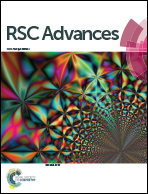DFT studies on the mechanism of palladium catalyzed arylthiolation of unactive arene to diaryl sulfide†
Abstract
Palladium catalyzed arylthiolation of benzene with 1-(phenylthio) pyrrolidine-2,5-dione to form diaryl sulfide has been studied with the aid of density functional theory (DFT) calculations. Two catalytic cycles (I and II) were considered. In catalytic cycle I, the active species reacts first with benzene, while in catalytic cycle II, the active species reacts first with 1-(phenylthio) pyrrolidine-2,5-dione. The calculations show that catalytic cycle I is more favorable than catalytic cycle II. The reaction proceeds through C–H bond activation, concerted σ-bond metathesis, isomerization, ligand exchange, N–H protonation, and ligand exchange steps, where the concerted σ-bond metathesis is found to be the rate-determining step. The present mechanism slightly differs from the mechanism proposed by experiment, in which an oxidative addition step rather than metathesis is involved. The frontier molecular orbitals were analyzed to understand the nature of the different reaction mechanisms between concerted σ-bond metathesis and oxidative addition. It was found that the HOMO–LUMO interaction results in concerted σ-bond metathesis, while the interaction between HOMO−1 and LUMO gives oxidative addition, and thus, the concerted σ-bond metathesis is more preferred in the arylthiolation reaction.


 Please wait while we load your content...
Please wait while we load your content...